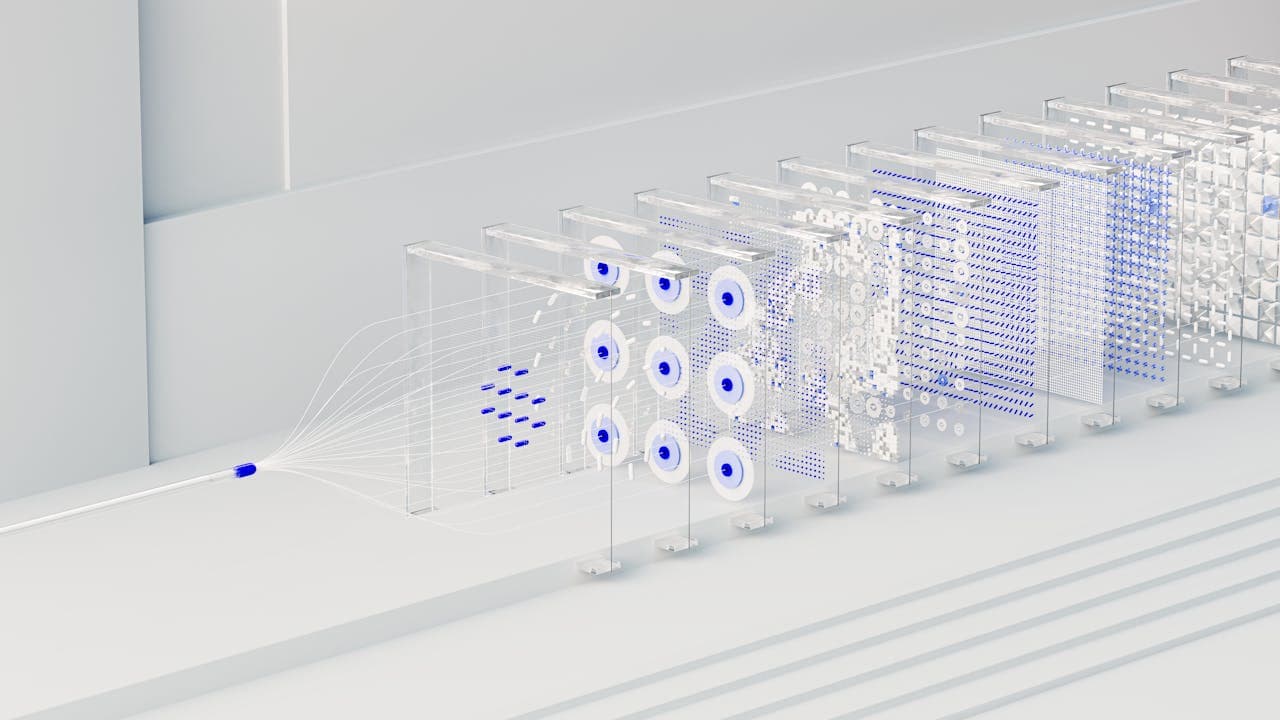How Network Topologies Affect Data Transfer

A network topology is the arrangement of devices, or nodes, such as routers, printers, and cables, on a network. It outlines how the nodes interconnect and how data flows between them. There are two categories of network topologies: physical and logical.
A physical topology denotes the layout of network cables and hardware, while a logical topology illustrates data routes and how devices communicate. There are five main types of network topologies: mesh, star, ring, bus, and hybrid.
Let's compare different topologies to determine how each affects data transfer.
Mesh Topology
A mesh topology is where all nodes are connected in a decentralized manner. Nodes communicate via other nodes, which act as relays, forwarding data and finding the most efficient paths to transmit it.
Mesh topologies emerged in the 80s, when militaries used radios as routers, and grew more popular in the 2000s, when Wi-Fi mesh networks became prominent.
They can be partially or fully mesh. In a partial mesh, nodes communicate with nodes nearby, but in fully meshed topologies, nodes can calculate and find the quickest paths to relay information.
Pros
- Nodes can find alternative routes if a connection fails, enhancing reliability and fault tolerance.
- Since data travels between nodes, it reduces latency and delays in transmission, enhancing the transfer speed.
- Mesh network types can handle large amounts of data transfer, since multiple nodes can send data simultaneously.
- Nodes can dynamically reroute data to reduce network congestion.
Cons
- The process of implementing and maintaining a mesh network is complex and expensive
- Adding nodes to the network disrupts it, increasing the workload
Ring Topology
A ring topology is a network layout where each device on a network is connected to exactly two other nodes, creating a closed loop for data to travel. Data travels from node to node, passing through each device before reaching its destination.
Most ring topologies are also called one-way unidirectional ring networks, since data travels in only one direction. However, each device gets an equal chance to transmit and receive data through tokens.
A sender node fills an empty token with information, including its MAC address and the recipient's MAC address, then delivers the token to the next node in the network. The next node decodes the token, reads the recipient's MAC address, and forwards it to the next node, which repeats the process until the data reaches the recipient.
When the recipient receives the token, it reads the message, copies the data, sets the token to zero, and forwards it to the next node. The token circulates again through the nodes until new information is sent.
Pros
- The ring topology uses tokens to eliminate collisions. Only one node can transmit at a time.
- The topology ensures equal opportunity to transmit data, and each node gets a chance to share data.
- Ring topology is excellent for small-to-medium networks because it's more efficient than bus topology.
Cons
- In case of a broken cable or node, the network will fail because the nodes cannot complete the circuit.
- Adding or removing a node will break the network and cause a temporary outage.
Star Topology
A star topology is a network design where nodes are linked to a central device, such as a switch, hub, or router, which forwards transmissions. Nodes don't communicate directly; they send data to the central device, which transmits it to the recipient.
The star topology first came about in telephone systems and was popularized in the 1970s by ARCNET in computer networks. Ethernet made the star topology popular in the 80s, and its cost-effectiveness helped the topology to dominate the 2000s.
A star topology can be active or passive. In an active star topology, the central device regenerates and boosts signals to ensure they're strong enough to reach their destinations. In a passive star topology, the device only transmits the signals. It's best for small-scale, short-distance setups.
Pros
- Using a switch minimizes congestion because it uses the nodes' MAC addresses to send data.
- Each node connects to the central hub with a dedicated cable, allowing efficient data exchange.
- If a node is damaged or the cable fails, the network is not affected, and other nodes continue to work smoothly.
- Users can add or remove nodes or use fiber optic and coaxial cable without disrupting the rest of the network.
Cons
- Setting up a star topology is more expensive than bus and ring topologies since it requires cabling and a central hardware
- The entire network becomes inoperative if the central hub fails
Bus Topology
A bus topology is a network layout where nodes connect through a central cable called a backbone or bus. Nodes transmit data to the left and to the right, but only the intended recipient accepts it.
The shared coaxial or network cable acts as a communication medium for nodes. Each node on the network receives the transmission, but only the node with the matching MAC address to the destination address accepts the data.
The main cable ends are fitted with terminators to absorb signals and prevent bounce backs. When data reaches the extreme ends of the cable, terminators remove the data from the channel.
Pros
- Bus topology is cost-effective since all nodes connect using a single cable, unlike other network types, which require many cables.
- It's easier to install, set up, and configure the network, even for people with minimal technical knowledge.
- Nodes can connect to the backbone cable without complex configuration, and new networks can join by tapping into the cable.
- It supports high-speed data transfer rates since the data is sent via a single cable.
Cons
- Since nodes broadcast data to every device, the network is not safe. Any node can receive all the data transferred.
- The topology can lead to data collision if nodes try to send data simultaneously.
Hybrid Topology
A hybrid topology combines two or more topologies, such as star, ring, and bus. It leverages the strengths of each topology, creating a more scalable, reliable, and flexible network than a single topology can offer.
Common hybrid network topologies include star-wired ring, star-wired bus, and hierarchical network topologies. Other hybrid topologies include ring-mesh, bus-mesh, and multi-ring.
Star-wired ring topologies are common in ISPs, while factories use star-wired bus topologies to connect old machines with new ones as they wait for rollover. Companies use hierarchical topologies to cut costs and reliability, based on how critical each part is.
Pros
- They're cost-effective since you can deploy mesh networks only where you need high availability.
- There's no need to overengineer a network; You can simply put the redundant devices in non-critical paths
- You can easily adapt with growth and add more devices, departments, and new sites ad hoc
- Administrators get fancy traffic management features that allow them to control the nodes
Cons
- Managing and troubleshooting the network can be challenging since multiple topologies are involved.
- Installation can be difficult since the topology may require a large amount of cables.
Conclusion
The type of network topology you choose for your company or business depends on your budget, size, and speed requirements. Each topology offers unique advantages that you can leverage to save costs and increase speed.
A hybrid network topology might be most suitable for medium-large companies that want to connect different departments of computers. Small companies can do well with ring, star, or bus network topologies.

A network topology is the arrangement of devices, or nodes, such as routers, printers, and cables, o...

Cloud computing and cloud storage are two different things. Learn the differences between the two an...

A server OS is the base on which server applications and services run. CentOS 7 is one of the most p...

Writer CMS serves as the backend and admin interface for a content creation and article management p...

The Inventory Mobile App is a cross-platform mobile application built with Expo that enables users t...

The Inventory CMS is a web application built with NextJS for users to manage stock, track inventory ...

A beautifully crafted mobile app built with React Native and Expo that allows users to browse, searc...

YouTube is packed with amazing tutorials, tech talks, and courses — but it's easy to get lost in the...